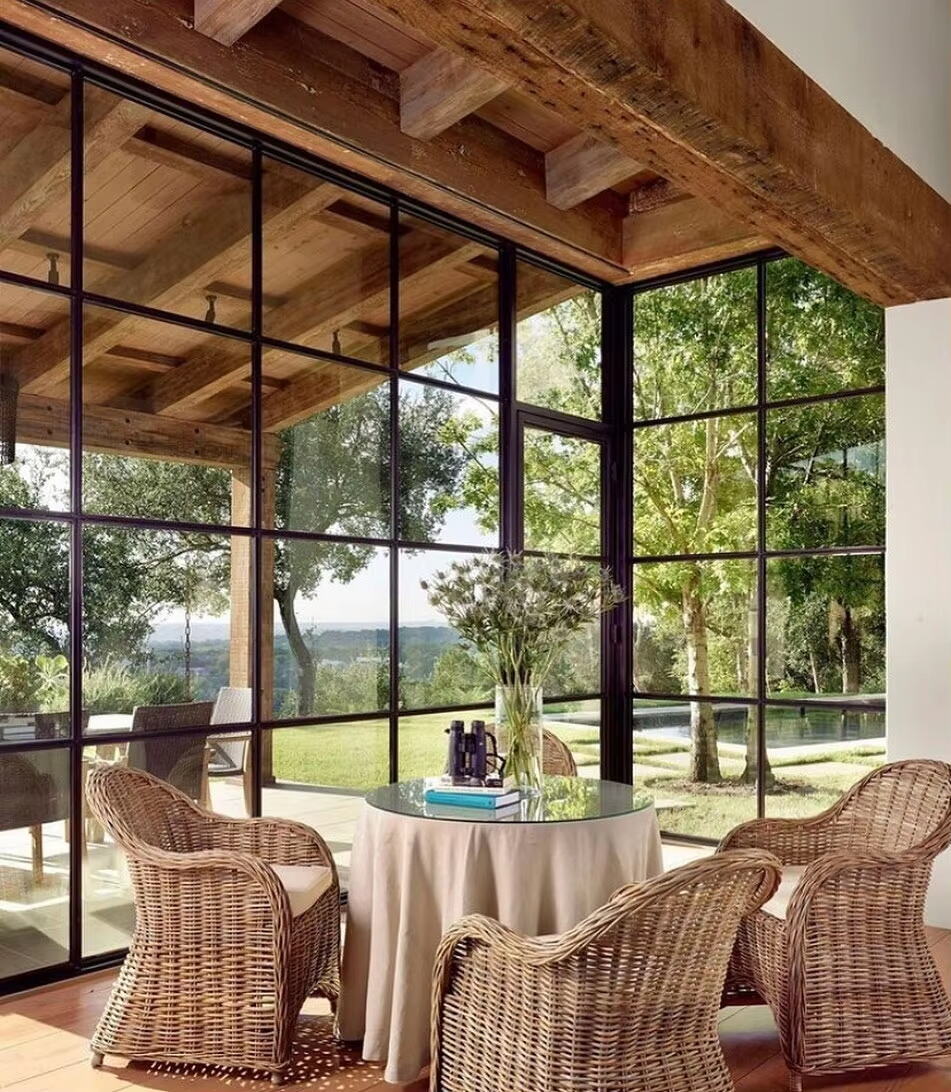건축 요소의 진화: 강철의 부상과 두드러짐
현대 건축은 건축 자재의 놀라운 변화를 경험해 왔으며, 강철 문 창문이 현대 디자인의 상징으로 등장했습니다. 이러한 건축 요소들은 공간을 인식하고 건설하는 방식을 혁신적으로 변화시켰으며, 내구성, 미학, 기능성의 완벽한 조화를 제공합니다. 전통적인 목재 마감재에서 고급 강철 설치재로의 여정은 우리의 변화된 건축 선호도와 기술 역량을 반영하고 있습니다.
오늘날의 건축 환경에서는 시간의 시험을 견디면서도 뛰어난 시각적 매력을 제공할 수 있는 소재가 요구됩니다. 강철 문과 창문은 독특하면서도 지속 가능한 공간을 창출하려는 건축가, 디자이너 및 주택 소유자들이 선호하는 선택이 되었습니다. 최소한의 주거 공간부터 웅장한 상업용 건물에 이르기까지 다양한 적용 분야에서 보여주는 유연성은 현대 건축 설계의 핵심 요소로 자리 잡았습니다.


디자인 다기능성과 미적 매력
세련된 프로파일과 현대적인 미학
강철 문과 창문은 자연광과 전망을 극대화하면서도 구조적 안정성을 유지하는 매우 얇은 프로파일을 제공합니다. 강철의 본래 강도 덕분에 다른 소재에 비해 더 얇은 프레임을 구현할 수 있어 어떤 건축 스타일에도 잘 어울리는 우아하고 세련된 외관을 연출할 수 있습니다. 이러한 얇은 프로파일은 더 큰 유리 패널을 지지할 수 있어 실내와 실외 공간의 경계를 흐리는 극적인 천장 높이까지 이어지는 설치 효과를 만들어냅니다.
스틸 프레임의 깔끔한 라인과 미니멀리스틱한 미학은 전통적 및 현대적인 디자인 모두를 한층 더 돋보이게 하는 영원한 매력을 제공합니다. 역사적인 건축물의 리모델링이든 현대적인 신축 건물이든 상관없이 스틸 도어와 창문은 전체 건축 구성에 고급스러움을 더하는 요소로 작용합니다.
커스터마이징 옵션 및 마감 가능성
스틸 도어와 창문의 가장 매력적인 특징 중 하나는 다양한 디자인 요구사항에 대응할 수 있는 뛰어난 적응성입니다. 제조사에서는 단순한 단일 패널부터 복잡한 기하학적 패턴에 이르기까지 거의 모든 형태로 이러한 요소를 제작할 수 있습니다. 또한 이 소재는 다양한 색상과 질감으로 마감이 가능해 건축가들이 소재가 지닌 본연의 강도를 유지하면서도 구체적인 디자인 목표를 실현할 수 있습니다.
다양한 코팅 옵션, 즉 파우더 코팅, 아연도금 및 환경 요소에 대한 보호 기능과 시각적 매력을 동시에 갖춘 특수 마감재까지 적용할 수 있는 다용도성도 제공됩니다. 이러한 마감 처리를 통해 강철 도어와 창문이 어떤 색상 구성이나 건축 스타일에도 자연스럽게 조화될 수 있도록 보장합니다.
구조적 안정성 및 성능 이점
뛰어난 강성 과 내구성
강철의 뛰어난 구조적 특성은 현대 건설에서 도어와 창문 제작에 있어 탁월한 선택이 됩니다. 강철은 높은 인장강도 대 중량비로 인해 안정성을 희생하지 않으면서도 더 넓은 개구부와 보다 대담한 디자인을 가능하게 합니다. 이러한 설치물은 극한의 기상 조건이나 빈번한 사용, 잠재적 충격에도 견디며 수십 년 동안 외관과 기능성을 유지할 수 있습니다.
시간이 지남에 따라 휘어지거나 부패하거나 손상될 수 있는 다른 소재와 달리, 제대로 관리된 강철 문과 창문은 수명 동안 구조적 완전성을 유지합니다. 이러한 내구성은 교체 비용을 절감시키고 건물의 가치를 높여 주며, 주거용 및 상업용 부동산 모두에 있어 현명한 투자가 됩니다.
강화된 보안 기능
현대 건축에서 보안은 무엇보다 중요한 문제이며, 강철 문과 창문은 이 측면에서 뛰어납니다. 강철의 본래 강도는 침입 시도에 대한 우수한 저항성을 제공하며, 최신 잠금 장치를 프레임에 자연스럽게 통합할 수 있습니다. 이러한 보안 기능은 미관상의 매력을 해치지 않으면서도 깔끔한 라인을 유지하고 안정감을 제공합니다.
최신식 스틸 설치물은 여러 개의 잠금 장치와 고도의 보안 하드웨어를 결합하여 주거용 및 상업용 요구사항을 모두 충족하는 종합적인 보안 솔루션을 제공합니다. 또한 이 소재는 내화 성능을 갖추고 있어 건물 전반의 안전성 향상에 기여하며, 보안이 중요한 분야에서 선호되는 선택이 됩니다.
환경성능과 지속가능성
에너지 효율 특성
일반적인 오해와 달리, 최신 스틸 도어와 창문은 적절히 설계되고 설치될 경우 우수한 단열 성능을 제공합니다. 최신 단열 기술과 고효율 복층 유리 옵션을 적용한 설치물은 에너지 효율성을 높여 난방 및 냉방 비용 절감에 기여합니다. 밀착된 밀폐성과 견고한 구조는 공기 누출을 최소화하여 실내 온도를 일정하게 유지하는 데 도움을 줍니다.
적절한 창호 솔루션과 결합된 강철 프레임의 열 효율성은 에너지 코드 요건을 충족하거나 초과 달성하면서도 원하는 미적 효과를 제공할 수 있습니다. 성능과 디자인의 균형 잡힌 조합은 강철을 지속 가능한 건축 프로젝트에서 점점 더 인기 있는 선택지로 만들고 있습니다.
지속 가능한 소재 특성
강철의 재활용 가능성과 긴 수명은 현대 건축에서 환경적으로 책임감 있는 선택이 됩니다. 이 소재는 특성이 저하되지 않아 무한히 재활용할 수 있으며, 많은 강철 제품에는 이미 재활용된 내용물이 포함되어 있습니다. 제품 이러한 순환적 생애 주기는 건축 자재의 환경 영향을 줄이면서 자연 자원을 보존합니다.
강철 문과 창문의 내구성은 시간이 지남에 따라 교체 빈도를 줄여 폐기물과 새로운 자재의 필요성을 감소시킵니다. 또한 유지 관리에 대한 요구 사항이 적어 수명 주기 동안 청소 제품과 자원의 사용을 최소화하여 전반적인 환경 지속 가능성에 기여합니다.
정비 및 장기적 가치
관리 및 유지 보수 요구 사항
강철 문과 창문은 외관과 기능을 유지하는 데 최소한의 관리만 필요합니다. 적절한 제품을 사용하여 정기적으로 청소하고 가동 부품을 주기적으로 점검하면 최적의 성능을 유지할 수 있습니다. 자주 페인트칠이나 밀폐가 필요한 목재 제품과 달리 적절한 마감 처리가 된 강철 제품은 간단한 청소로 외관을 유지할 수 있습니다.
전문적인 유지보수 일정은 건물 관리 계획에 쉽게 통합될 수 있으며, 대부분의 조치는 주요 수리보다는 정기 점검에 중점을 둡니다. 이로 인해 유지보수 부담이 줄어들어 장기적으로 소유 비용이 절감되고 성능이 지속됩니다.
투자 수익 및 부동산 가치
강철 문과 창문 설치는 부동산 가치에 대한 중대한 투자입니다. 이러한 설치품의 우수한 품질과 내구성은 종종 부동산 재판매 가치를 높이고 잠재 구매자나 임차인을 유치합니다. 고전적인 매력과 장기적인 성능 특성 덕분에 주거용 및 상업용 부동산 모두에서 귀중한 자산이 됩니다.
강철 설치품의 초기 비용은 긴 수명, 낮은 유지보수 요구사항 및 에너지 효율성 혜택에 의해 상쇄됩니다. 전 생애 주기 비용을 고려할 때 자주 교체하거나 광범위한 유지보수가 필요한 대체재보다 강철 문과 창문이 경제적인 경우가 많습니다.
자주 묻는 질문
강철 도어와 창문의 일반적인 수명은 얼마나 됩니까?
적절한 관리와 유지가 이루어진다면 강철 문과 창문은 50년 이상 사용할 수 있습니다. 이들의 내구성은 알루미늄이나 목재 대체재를 크게 능가하며, 귀하의 부동산에 대한 장기적인 투자가 됩니다.
강철 도어와 창문은 에너지 효율이 좋은가요?
현대식 강철 도어와 창문은 최신 단열 기술을 적용할 수 있으며 고효율 복층 유리를 장착할 수 있어 매우 에너지 효율적입니다. 올바르게 설치된 경우, 난방 및 냉방 비용 모두에서 상당한 에너지 절약 효과를 제공합니다.
강철 도어와 창문은 어떤 유지보수가 필요한가요?
유지보수는 비교적 간단하며, 적절한 제품을 사용한 정기적인 청소, 움직이는 부품의 주기적 윤활, 그리고 방풍 실링 상태 점검으로 구성됩니다. 목재와 달리 페인트칠이나 밀폐 처리가 필요하지 않으며 휘어짐이나 부패에 강합니다.

